Years ago automotive engines were measured in displacement in cubic inches. The GM 350 cubic inch block is today's 5.7 Liter engine. Use the US standard or the metric standard, it matters not, it's all a matter of volume.
As to the Dippers? Sitting down with a cup of powder (of your choosing) and a dipper go ahead and dip ten charges weighing each one, try ten with the dipper leveled and ten with the dipper unlevel. That is what I did above with the posted excel table. Running your own comparisons is not complicated or difficult. Apply the powder VMD (Volume Measured Density) and note what you should have and what you actually have.
In my example I used a 2.8cc (cubic centimeter) dipper. The powder was IMR 4064. IMR 4064 has a VMD of about .0745 and we say about because the VMD of any given powder, lot to lot will vary. There are other variables like temperature and relative humidity because as we know powder is hydroscopic stuff. Hygroscopy is the phenomenon of attracting and holding water molecules from the surrounding, usually at normal or room temperature, environment. Does it matter? Not likely to come in use of the application in this case. The dipper I used was not quite giving a high measure of repeatability nor was it spot on with respect to the 37.6 grains which should have been my charge weight. Your mileage may vary.
All of that said people have been loading perfectly good ammunition using Lee Dippers for decades. People have also managed plenty good enough powder charges with the RCBS Uniflow and similar powder throws which rely on volume charge to charge. I watch bench rest shooters load on the range using high end volume powder throws like the Harrell's Precision versions.
As to the original post and the 7,000 grains? Personally, based on my own observations, I do not see it happening unless it was a one in several million long shot. All methods for measuring the weight of powder charges come with some uncertainty, the only thing that matters is will that uncertainty come in light of the intended application?
Ron

